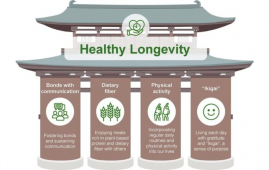

Disability-Free Life Increasing Among Older Americans, Study Finds
A new study has revealed a significant rise in the number of older Americans living without any disability, suggesting an encouraging trend in aging and overall health. Published in Archives of Gerontology and Geriatrics Plus, the research found that from 2008 to 2017, the proportion of U.S. adults aged 65 and older without serious disabilities—including memory, hearing, vision, and functional impairments—rose from 61% to 65%.
While this four-percentage-point increase may appear modest, it translates to 2.07 million fewer older Americans experiencing serious disabilities in 2017 than would have been expected had the 2008 prevalence remained unchanged. The findings highlight improvements in quality of life and potential reductions in long-term healthcare demands.
“Such a dramatic improvement over a short period is extremely encouraging,” said senior author Esme Fuller-Thomson, Director of the University of Toronto’s Institute for Life Course & Aging. “Older adults without disabilities are less likely to require extensive healthcare services and can maintain greater independence.”
The study analyzed data from 5.4 million respondents over ten years, collected through the nationally representative American Community Survey. Researchers defined individuals as disability-free if they reported no serious difficulty with memory, vision, hearing, daily activities such as dressing, or functional mobility like walking and climbing stairs.
Interestingly, the study found a notable shift in gender trends. In 2008, men were more likely to be disability-free than women (62.7% vs. 59.4%). However, women experienced a steeper improvement rate over the decade, closing the gap by 2017.
Researchers suggest that higher educational attainment among post-war generations may have contributed to this progress. Education is linked to healthier lifestyle choices, such as reduced smoking rates, and access to less physically demanding jobs, which can lower the risk of late-life disabilities.
However, the study notes that gains in disability-free living were mainly seen in those 75 and older, with little improvement among younger seniors (65-74). Researchers speculate that higher obesity rates among Baby Boomers may slow future progress.
As life expectancy rises, understanding the factors influencing disability-free aging will be crucial in shaping policies and healthcare strategies for an aging population.
More Information: Kelly-Adams, D., & Fuller-Thomson, E., (2024). The Silver Lining: A Decade of Improvement in Disability-Free Living among Older Americans (2008-2017). Archives of Gerontology and Geriatrics Plus. doi.org/10.1016/j.aggp.2024.100113
more recommended stories
 How Soybean Oil Impacts Weight Gain and Metabolism
How Soybean Oil Impacts Weight Gain and MetabolismWhy Soybean Oil May Affect Metabolism.
 New Malaria Prevention Insights From African Biostatistics
New Malaria Prevention Insights From African BiostatisticsHow New Data Is Reframing Malaria.
 World Summit Outlines Core Principles for Healthy Longevity
World Summit Outlines Core Principles for Healthy LongevityWhy Healthy Longevity Demands a New.
 Gut Immune Cells and Long-Lasting Antiviral Protection.
Gut Immune Cells and Long-Lasting Antiviral Protection.Breakthrough Findings on How Gut Immune.
 Mild Pancreatic Duct Dilatation Signals Higher Cancer Risk
Mild Pancreatic Duct Dilatation Signals Higher Cancer RiskEarly Structural Changes Offer Critical Clues.
 Ultra-Processed Foods in Mediterranean Youth: Risks
Ultra-Processed Foods in Mediterranean Youth: RisksThe Mediterranean region is widely recognized.
 Intensive mind-body retreat rapidly alters brain function
Intensive mind-body retreat rapidly alters brain functionAn intensive mind-body retreat combining meditation,.
 Longevity Gene May Extend Lifespan Without Strict Diets
Longevity Gene May Extend Lifespan Without Strict DietsThe search for safe and realistic.
 Cholesterol-Lowering Drugs May Help Reduce PFAS Levels
Cholesterol-Lowering Drugs May Help Reduce PFAS LevelsPer- and polyfluoroalkyl substances (PFAS) continue.
 Citrus and Grape Compounds Help Prevent Type 2 Diabetes
Citrus and Grape Compounds Help Prevent Type 2 DiabetesA new clinical trial highlights the.

Leave a Comment